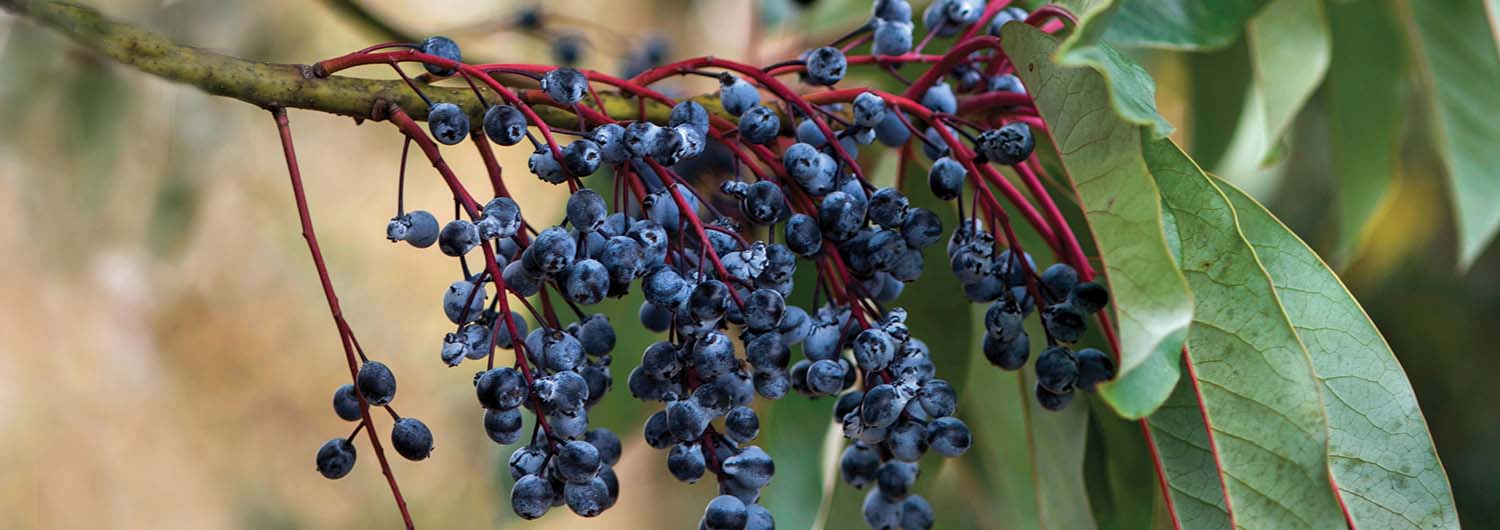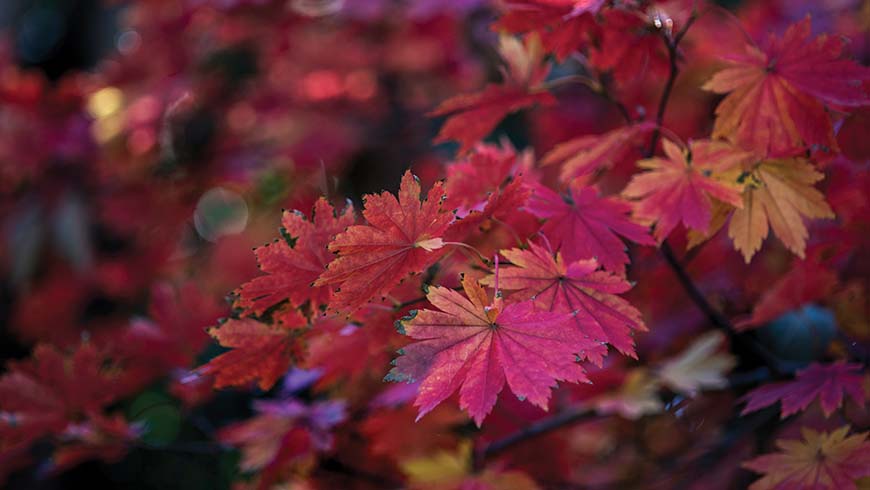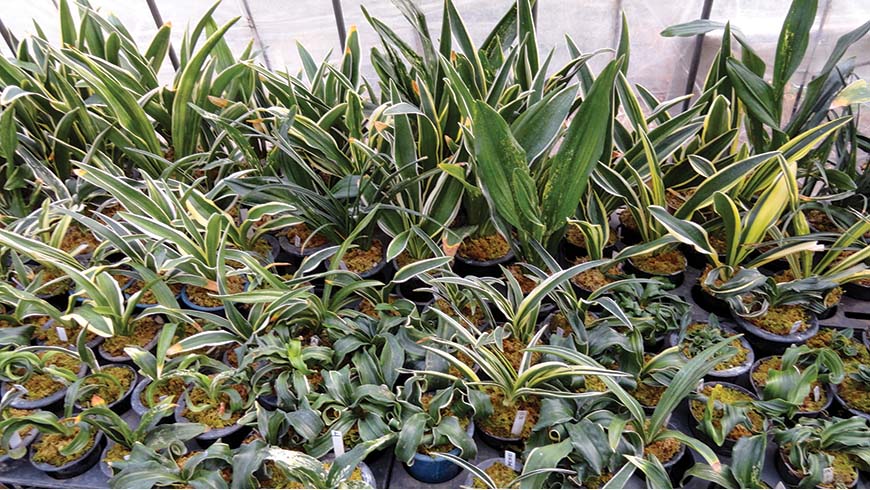Friends of the JC Raulston Arboretum Newsletter
Fall 2020 – Vol. 23, No. 2
Director's Letter
Greetings from the JC Raulston Arboretum
By Mark Weathington, Director
Well, I must have been reading the tea leaves correctly when I wrote my greeting for the spring newsletter. At the time, I was thinking about resiliency, both from a horticultural perspective as well as a financial one. Who knew how important resiliency would actually be this year? I can't help but be impressed with the resiliency of my staff. As soon as the gates shut in March, they were quickly figuring out how we could best deliver our mission—and deliver they did, and continue to do so with outstanding online offerings and access to amazing plants. I couldn't ask for a better, more resilient group of colleagues to work with and ride out this crazy year.
One issue that has become a real focus across the country is the legacy of systemic inequalities. While we, as Americans, look towards our own shameful past and reckon with the statues, schools, roads, and more erected or named for Confederate generals and segregationists, there is an even longer history of European colonialism embedded in everyday life. One area which we at the JCRA will be focusing on is the common names that have been applied to many of the plants we grow.
More often than you would think, these names which we don't give a second thought to are offensive or derogatory. A common example is Pinus sabiniana, known colloquially as "digger pine." European settlers in California during the gold rush called the Paiute this name as a slur in reference to their use of roots as food. The term is still offensive to many peoples and most modern references prefer the common name "gray pine," which also better describes the glaucous gray-colored needles it bears.
The JCRA is committed to working with our public garden colleagues in an effort to address this problem, starting with the names you see on our labels and signs. While we have always excluded the most obviously racist names, others will likely be new to us and require research. For instance, does the common name of Veronica perfoliata, digger's speedwell, have a negative origin in Australia where it is native? Apparently not, as far as we can tell. While these name adjustments will not change centuries of Eurocentric actions, we hope this is one small step towards righting the often-hidden history of racism in our gardens.
Horticulture
Koten Engei Coming to America
By Mark Weathington, Director
Japan has had a profound influence on Western horticulture for the past 200 years or more. Many of our most popular landscape plants—azaleas, peonies, flowering cherries, hydrangeas, and so many more—were introduced from the gardens of Japan. In addition to plants, specialized horticultural techniques such as bonsai (which was itself introduced from China as penjing) and more recently ikebana have become quite popular in the United States. But perhaps the most uniquely Japanese horticultural tradition, known as koten engei, has never gained the popularity of these other art forms.
Barry Yinger, a scholar of Japanese horticulture and friend of the JCRA, says translation of koten engei is all but impossible and can perhaps be summed up as "the cult of classical plant culture." Certain plants, usually Japanese natives, with a special focus on all sorts of mutations with minor variations in variegation patterns, growth habit, and other differences are selected and displayed in pots which are often specific for certain types of plants. Plants are selected and ranked for appearance and rarity with the weakest and hardest to grow often the most desired. If you have ever been to a koi show, you may understand: the brightest, biggest, and showiest fish are often the least valued while others with minor differences command thousands of dollars.
Without a lifetime submersion in their culture, it may be close to impossible to truly understand the emotions associated with these plants by Japanese enthusiasts, but an appreciation for the variety and beauty can be felt by any plant lover. As a long-time grower of many of the plants traditionally grown as koten engei, especially Asarum (wild ginger), Ardisia (marlberry), Rohdea (sacred lily), and various orchids, I have always cherished visits to collectors and displays of these plants when in Japan and have long dreamed of the opportunity to showcase this tradition to my fellow countrymen. Now, thanks to a grant from the Japanese Foundation Center for Global Partnership, the JCRA will be able to develop two display collections and associated interpretive signage as well as an online educational symposium on December 12, 2020.
Our first collections will include Ardisia japonica, or yabukouji, and Rohdea japonica, called omoto in Japan. The JCRA already holds what is almost certainly the largest collection of Ardisia japonica outside of Japan with 44 selections, and we will work with Tony Avent to develop a world-class omoto collection. We look forward to displaying the collections on-site and online and to developing further collections, workshops, and programming. I hope others will learn to love this classic Japanese tradition as much as I do. Perhaps the JCRA will be the starting point for koten engei to rival the popularity of bonsai and ikebana in the United States.
If you are interested in supporting this program, please get in touch with me directly at mark_weathington@ncsu.edu as grant funds will not cover all our costs. We will also be looking for a volunteer or two to care for these collections.
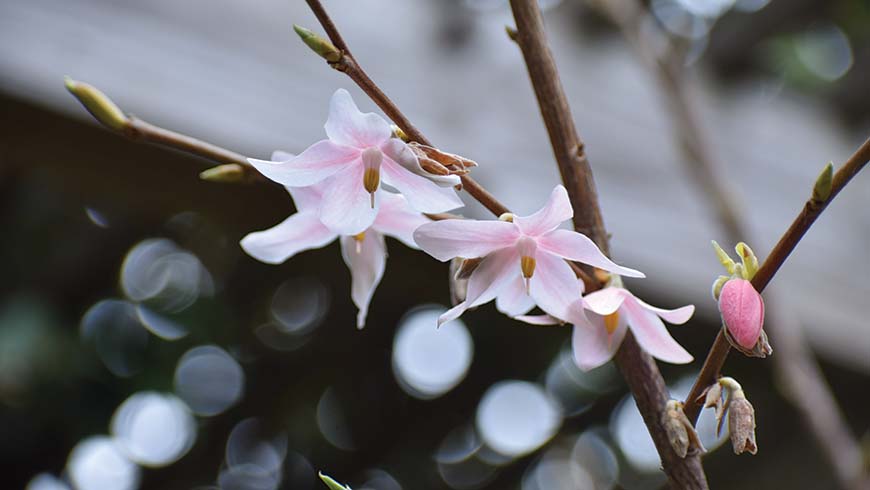
The Styracaceae
By Mark Weathington, Director
Few plants are more closely associated with the JC Raulston Arboretum than 'Emerald Pagoda' snowbell (Styrax japonicus 'Emerald Pagoda'), collected by J. C. on his 1985 expedition to South Korea and introduced almost a decade later. Although 'Emerald Pagoda' is the best known and is rightly appreciated for its exceptionally large flowers and tidy upright, oval habit, it isn't the only Japanese snowbell released by the Arboretum. 'Crystal' is a heavy blooming, smaller flowered form with purple flower stalks (pedicels) and deep green foliage growing happily in the White Garden, while 'Snowfall', a very dense and compact-headed selection, is unfortunately no longer growing at the JCRA. These Japanese snowbells and the ones which have been released from other sources are rightly considered exceptional flowering trees.
If you were to look in nursery catalogs and among collections, you might be forgiven for not realizing that there is more to this group than the Japanese species. In fact, there are 11 related genera in the Styracaceae family, with around 160 to 180 different species ranging from southern Canada to Mexico, the Mediterranean region, Asia, and Malaysia. By far the biggest group is Styrax, with about 130 species. The other 10 genera each have five or fewer species. Over the years, the JCRA has grown, with various success, eight of the genera. It is always difficult to generalize too much about plant families, but most of the trees and shrubs that make up this group have smooth bark, are deciduous with a few notable exceptions, have white flowers with usually four to six petals and two to four times as many anthers as petals.
The JCRA's 2019 plant collecting trip to China with Scott McMahan of the Atlanta Botanic Garden and Donglin Zhang of the University of Georgia took us near the junction of the Hunan, Jiangxi, and Guangdong provinces after a brief stop to give a lecture at the Shenzhen Botanic Garden. From there, we moved north to Sanquinshan. The region we were visiting was especially rich in Styracaceae, according to regional floras. As snowbells and their relatives are among the JCRA's prime collections, I was definitely on the hunt.
We came across a Melliodendron xylocarpum, one of the largest flowered genera in the family, on Jinggangshan at a very low elevation. We've grown the monotypic (having only one species in the genus) melliodendron for about as long as anyone in the West, receiving seed of it as early as 1992, but some records indicate there may have been plants here in the 1980s. Melliodendron is one of the few plants in the family bearing single (sometimes two) flowers in the leaf axils rather than a cluster of flowers. It makes up for fewer flowers by making them big. Pink to white buds in spring open to reveal paler, often almost white flowers to 2" across. The fruit on the tree we found in China was smaller than what I've seen in cultivation, but it was certainly recognizable. It is not the easiest seed to germinate and patience seems to be the key. The selection currently growing at the JCRA came from Garden Kinosato in Japan as an unnamed, very good clone. We dubbed it 'Suzuki Pink' (photograph above, page 3) after the owner of the nursery.
Most genera which can be found both in China and the eastern United States have more species in Asia than here in North America. One exception is Halesia, or silverbell. Of the three to five species, depending on your taxonomist of choice, only one is found in Asia. Our native silverbells, H. diptera and H. tetraptera (H. carolina), the two-winged and four-winged silverbells, respectively, are lovely spring flowering trees with masses of showy white flowers. Four-winged silverbell grows sporadically throughout the eastern United States. It can ultimately become quite a large tree whereas the Southeastern two-winged silverbell grows as a shrub or small flowering tree. H. diptera growing in the eastern part of its range is often designated as variety magniflora for its larger flowers. As a botanical name, this designation is likely not valid as flower size varies across its range, but gardeners should be on the lookout for plants with this name as they tend to be the showiest. A rarely seen but much coveted plant is the Chinese H. macgregorii, which the JCRA grew for quite a few years until the drought of 2007 took it out. I am not ashamed to say several of us danced a bit when someone's sharp eyes noticed the fruit of this species dancing over our heads at a middling altitude on Bamianshan. We look forward to growing this rare species once again.
The snowbells are, of course, the genus for which this family is known and the region we explored in China in 2019 has many species. Unfortunately, we did not see many plants with fruit other than Styrax odoratissimus. The lone specimen we found was a lovely plant in full sun with broad, rough-textured foliage and long, branched flower panicles which had ripened into ½" fruit with relatively small seeds. The Arboretum is currently growing about 21 species and selections of snowbell and has grown many more in the past. We hope to continue our searches for species of this exceptional genus which we believe has quite a lot to offer the American landscape. Our trials do not exclude our own natives, and a lovely blue-tinged foliage form of the shrubby Styrax americanus called 'Baby Blue' has been a winner. There are some Southwestern as well as Mexican species we hope to try again when we can get our hands on them.
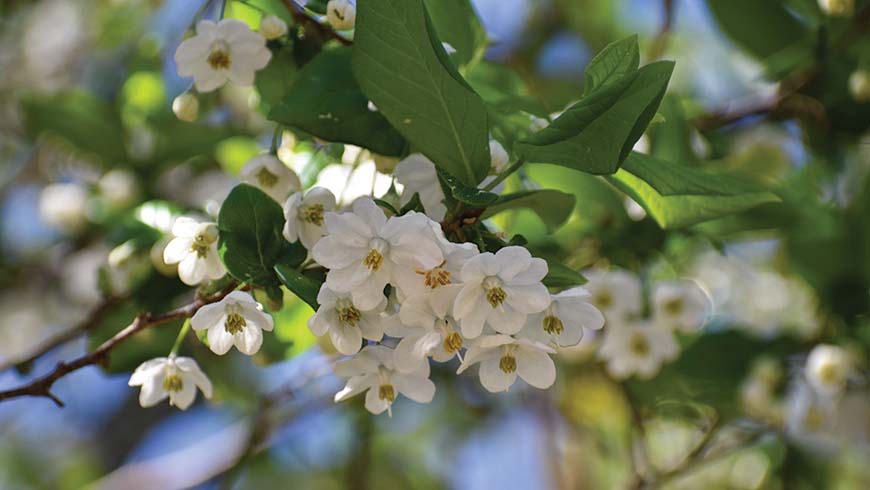
Space and time keep us from anything more than a passing mention of others in the family we love, such as the Sinojackia xylocarpa 'La Grima' (photograph above) which graces our brick circle and the always coveted Huadendron with its glossy bark and leathery leaves. Whatever the species, whatever the genus, the Styracaceae is one family that doesn't have any members to be embarrassed about. I wish we all could say that about our own families.

A Year Like No Other (Hopefully)
By Douglas Ruhren, Gardens Manager
This year has been a year like no other. Let's hope it always remains so. This pandemic has changed many things at the JC Raulston Arboretum. The three biggest are probably: 1. No visitors, 2. No volunteers, 3. Employees working at home if their work can be done remotely. Yet the Arboretum plantings have not gone downhill; indeed, there have been quite a few accomplishments.
Tim Alderton and I weren't able to do our job remotely; so many tasks that dominate our workdays such as planting, weeding, mulching, mowing, pruning, propagation, etc., just couldn't be done remotely. The first few months were the low point. Tim and I were not allowed to work at the same time, so we alternated four-hour mornings and afternoons. It was a good day when we were once again allowed to work eight-hour days at the same time while practicing all essential safety procedures. Even better was when the 2020 summer interns were able to start. Their start was delayed by six weeks, but it was a great time when they were here.
Arboretum horticulture employees walked much more than usual this summer, as a COVID-19 related University directive prohibits more than one person per vehicle. Tim liberated his collapsible bicycle from the trunk of his car and often used it as his mode of transportation—one might think to keep up with the Gators and golf cart—but more often it was the latter that were keeping up with Tim.
I truly believe that if you were able to visit the JCRA today you would not be disappointed by its condition. We have kept weeds reasonably under control. I must thank Tim for his hours of spraying herbicide. The use of herbicide was made necessary by the absence of so many volunteer weeders. Of course, there are times when hand weeding is necessary, and it's amazing how much can be accomplished by six people working together, even while wearing masks on a hot summer day.
Some things would have happened even without a pandemic. The vines on the walls on the north side of the Ruby C. McSwain Education Center will look a lot different when you return. The vines sloughed off the building like a comb-over on a windy day over the summer. This called for cutting them down to start over. These vines are two cultivars of Boston ivy, Parthenocissus tricuspidata; the yellow foliaged 'Fenway Park' and the pink, white, and green marbled 'Ginza Light'. The JCRA's plant database indicates that they were planted in 2003. Boston ivy is one of the few vines that has successfully attached to these very dense and slick concrete walls, but with time, even these eventually became victims of gravity as their holdfasts could no longer secure 17 years of growth.
Perhaps the most rewarding project, one still underway, is the new beds bordering the recently installed drive around the Great Lawn (photograph above). They are broad mounded beds raised up to better define them as planted areas and to discourage our less garden sensitive visitors who might take the shortest route to the Great Lawn. There are new woody plants in these beds, spaced to give them enough room to reach maturity. At this moment, it might seem that herbaceous plants dominate the area, and in actual numbers they do, but they fill the area with plants rather than vast areas of mulch between very young trees and shrubs. Something is going to grow in open areas, so it might as well be ornamentals rather than weeds. The herbaceous perennials will have enough time in the early years of these beds to prosper or die, (their choice) and thus to be evaluated. Successful ones can be transplanted and/or propagated as the trees and shrubs take over the area allotted to them.
There has been a great deal of other new plantings this spring and summer. We've concentrated them in localized areas rather than scattering plants here and there. This way, it is ever so much easier to keep up with the necessary watering. One such area is another new rain garden, this one in Asian Valley, created by our four summer interns, guided by Bradley Holland, Horticulture Field Laboratory superintendent.
Several end-of-year appeal projects were funded in December 2019. The new plantings along the now one-year-old fence along Beryl Road (funded in 2018) would have been a splendid opportunity for the 2020 JCRA summer interns to experience design, execution of a design, planting techniques, and aftercare. It did not happen because of the imminent installation of fiber optic cables on our side of Beryl Road.
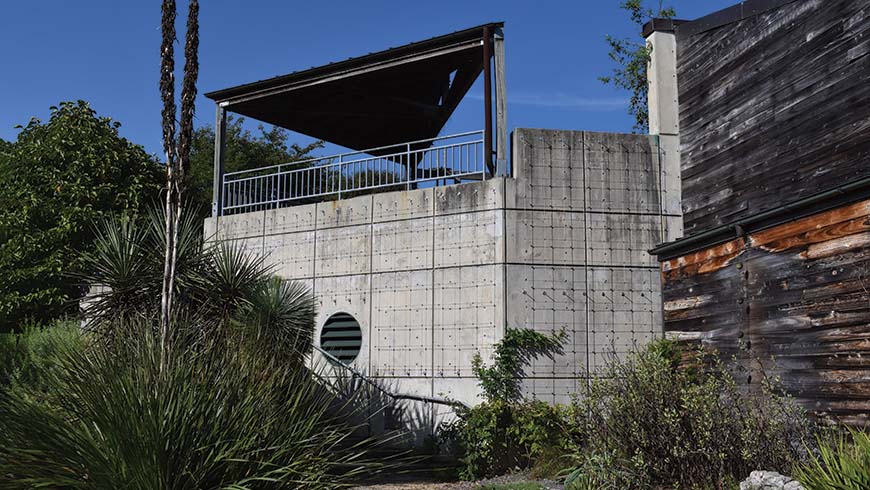
Also funded is a vine support system for the west end of the McSwain Center (photograph above). This is the 20' wall along the long flight of steps from the Scree Garden to the A. E. Finely Rooftop Terrace. It is the same system of stainless-steel cables and supports that was installed on the Bobby G. Wilder Visitor Center in 2017 (also funded by a JCRA supporter). This project was about to be installed when everything came to a standstill in March. In the last couple of months, the NC State facilities department reached out to the JCRA to say that the project was still on their to-do list, but all focus at that time was on getting campus ready for the beginning of the school year. In time, twining vines will cover this expanse of concrete wall to the delight of visitors and great benefit to the environment. Perhaps local high-rise builders will be inspired to add vines to their new buildings which have so little room for plantings.
The new arbor at the west entrance to the White Garden is in the brainstorming stage. It will very clearly mark this entrance and provide a photography spot for the Arboretum's visitors.
I want you all to know that JCRA staff is willing to do most anything to take care of your arboretum. To that end, we've had to gorge on figs to keep ahead of the ripening crop. Several times, I was able to harvest handfuls of fully ripe figs off the 'Violette de Bordeaux' without even getting off the seat of the golf cart. Yes, you are correct, that is the definition of decadence. So, on that note, I assure you the JCRA gardens are doing fine and I hope all of you are as well.
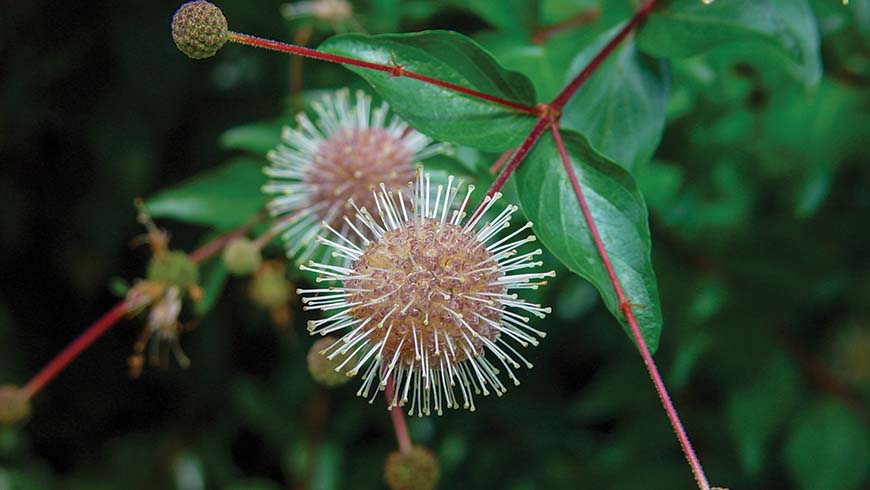
Botanically Speaking
By Mark Weathington
By now, everyone is very aware what coronavirus looks like thanks to a steady supply of infographics on TV, newspapers, and online. It was during an extra-long Zoom staff meeting when someone was getting a little punchy that the virus's resemblance to the flower of our native button bush (Cephalanthus occidentalis) was mentioned. Several other flowers and fruits were mentioned as other look-alikes and within minutes, a 2020 T-shirt idea was born. While the concept gave us all a much-needed boost and smile, the idea is certainly not to make light of a very serious issue which has affected us all—including at least one of our own former volunteers— but rather to roll with the punches and smile in the face of adversity.

The new T-shirt design sports our beautiful entry gate on front over the left side of the chest. The gate is, of course, closed, as it has been for most of 2020 and has a small nod to the elegance of the virus's form rather than the maple leaves which adorn the real thing. The back bears images of our staff's picks for the botanical COVID impostors including the flowers of the aforementioned buttonbush, Chinese buttonbush (Adina rubella, photograph above), Malayan aspen (Exbucklandia populnea), and the fruit of our native sweet gum (Liquidambar styraciflua).
Both buttonbushes are closely related and grow naturally in similar habitats at stream and pond edges. The tight clusters of flowers with extra-long pistils are much loved by pollinators and are quite showy, often being compared to Sputnik, although I don't think people really remember what the satellite actually looked like. Both will grow in average garden soil as well as damp sites where they become rather large, multi-stemmed shrubs. The Chinese plant is a bit more refined than our native, which is better suited for more naturalistic plantings.
The other two trees have at various times been placed in the same family although they appear quite different. Our native sweet gum, while much maligned for the gumball fruit it drops in the yard, is an easy to grow, adaptable tree with glorious fall color. Malayan aspen, on the other hand, is a virtually unknown plant, despite growing at the JCRA for nearly a decade with large, glossy, evergreen foliage and small, green starburst flowers. Native or exotic, tree or shrub, we think the shirt says everything that needs to be said about 2020 … botanically speaking at least.
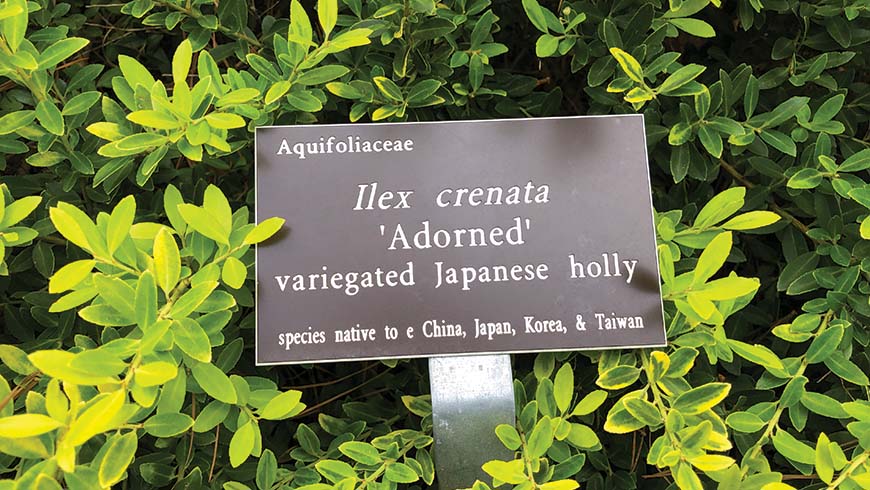
Behind the Label—JC Raulston Arboretum Record Keeping
By Dennis Carey, Database and Plant Records Coordinator
Behind the scenes, the JC Raulston Arboretum has a team of dedicated volunteers and staff who work tirelessly to manage our plant databases. Since most JCRA visitors never interact with the plant databases, we thought we'd pull back the curtain and give you a glimpse at the scale of this operation. We think you'll be surprised at how much information we track.
To give you some scope, the JCRA databases record each and every plant that has ever crossed our doorstep and has almost 14,000 living plant records, over 47,000 former plant records (dead or discarded), over 19,000 distributed taxa (given away for free or sold to the public), and just shy of 340,000 photographs that are cataloged and searchable. For each plant in the databases, we record hundreds of data points to track all the details that we need.
Our record keeping started in the 1970s with JC Raulston's handwritten 3" × 5" note cards. Over the years, we have upgraded our record keeping and now use a database platform called FileMaker in conjunction with mapping software called ArcGIS. The primary designer of the database was long-time JCRA employee Val Tyson. Since Andrew Pais's departure in late 2019, I have taken up the mantle of plant recorder and will continue to evolve the database into the future.
Why Is a Plant Database Important?
The JCRA has strategic goals of collecting plants, providing educational experiences, and serving as a living laboratory. To meet these goals, we use our databases to store interpretive and educational material for the public (e.g., garden labels, plant sale tags, sales signs, Web content). We record complete taxonomic data, provenance information, and garden evaluation notes to share with the green industry and other botanic gardens. We also store location, growth history, current size, and propagation information for our own use.
One example of the importance of this kind of information … we were recently contacted by a researcher at the Morton Arboretum in Chicago who was writing a scientific paper about Styrax and wanted information about some Styrax samples we shared with Morton years ago. Luckily, our plant databases has detailed plant records going back to the 1970s so we were able to provide the original source data of the plants, performance data from our garden, and updated taxonomic information to the researcher.
Who Does All This Database Work?
Garden staff (Douglas Ruhren, Tim Alderton, Ann Swallow) and administrative staff (Mark Weathington, Chris Glenn) continually add new photographs and plant data into the databases. Each year, the entire living plant collection is inventoried and the map locations and garden labels are checked for accuracy. An army of volunteers collects all this information and inputs the information into the databases. Thanks to them, our garden map accurately locates plants to less than a foot! (Thank you, volunteers!)
The databases aren't just for the staff or researchers. Thanks to Chris Glenn, the public can interact with parts of our databases via the JCRA Web site. Check it out!
If any of you are interested in working with the JCRA plant databases doing data entry, mapping, or labeling, please contact the JCRA volunteer coordinator Kathryn Wall at (919) 513-7004 or kbwall@ncsu.edu and express your interest. We'd be glad to work with you. It's great fun and you get to work with a great group of people.
Arboretum Updates
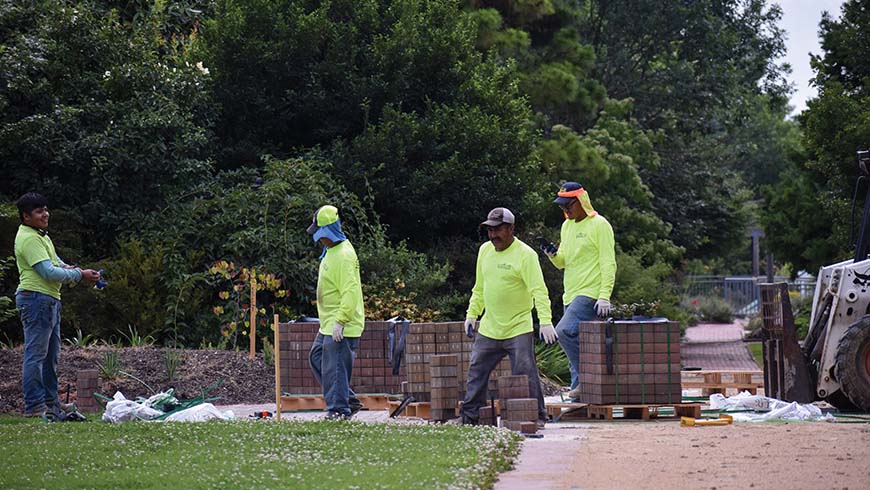
Pathway Progress
By Mark Weathington, Director
While we may not have made quite as much progress in the garden as we had planned when 2020 started, we certainly were not sitting idle. Without our dedicated cadre of volunteers weeding, planting, pruning, and mulching, Doug, Tim, and the interns had a lot of work on their hands just keeping the Arboretum green as temperatures sat in the 90s for much of the summer. One long-planned project from our Master Plan was implemented, though, and we couldn't be more pleased.
Back in 2006 when the Master Plan was first developed, there were a few major goals, including improving the visitor circulation and flow through the garden and increasing the accessibility of the entire grounds. From the beginning, the design team and staff envisioned a broad path around the perimeter of the Great Lawn that sits at the center of the JCRA. Thanks in part to grant funds from the NC Science Museums Grant Program, we have finally made that vision a reality. The new paver walkway provides a smooth and stable surface for all our visitors—from toddlers still learning how their legs work to folks with canes and walkers as well as strollers, wheelchairs, and those of us with two left feet.
The JCRA design team of dedicated volunteers and staff found pavers whose colors complement the existing grit walkway of the main path and its broad concrete border. It looks almost as though the new road has always been in place. When the plan was first described to some members, they expressed concern that we might be paving too much of the garden. The well-thought-out design instead reduced the amount of turf we maintain while preserving nearly all the usable space, and it even allowed us to add several new planting beds to frame the path. The motto of the design team has always been, "It's all about the plants," after all.
Of course, nothing is as simple as we might like. Right as we were preparing to move forward with the project, the paver manufacturer shut down because of COVID-19. Nearly two months later, we were able to finally get the pavers, but in the ensuing time we discovered that a significant portion of the path needed to be excavated almost 4' to find solid ground. All's well that ends well, though, and the heart of the JCRA is looking better than ever.
Beyond making the southeastern side of the Arboretum more accessible, the new pathway allows for maintenance and construction vehicles to enter the JCRA without damaging the collections. As the JCRA design team looks to make significant changes to the northeast quadrant of the garden, this path will definitely be used to bring needed equipment onto the grounds. Other construction and improvement projects funded by year-end gifts, donations, and grants are still in process throughout the Arboretum and are being implemented as time allows and resources are available.
Upcoming Educational Programs and Sales
Exploring the Diversity of Camellias✎
Brie Arthur, Author, Horticulturist, and Lifelong Home Gardener
Saturday, October 31
9:00 am–12:00 pm
Holiday Wreath Sale
Sunday, November 1 through Monday, November 30
Pickups available on Friday and Saturday, December 4 and 5
Gardens of the World Part Two: Western European Wonders✎
Bryce Lane, NC State University
Mondays, November 2 through December 14 (except November 23)
6:30 pm–8:30 pm
Plantsmen’s Tour
“A New Year Begins: The Second Growing Season”
Douglas Ruhren, Gardens Manager
Tuesday, November 3
1:00 pm–2:30 pm
Virtual Garden Storytime✽
Friday, November 13
10:00 am
Rare Plant Auction
Friday, November 6 through Saturday, November 14
Moonlight in the Garden Music Series
Saturdays, November 7 and 21
7:00 pm
Fall Symposium✎
“Falling for Color”
Featuring Dan Benarcik, Chanticleer; Eileen D. Boyle, Mt. Cuba Center; Jim Harbage, Ph.D., and Jim Sutton, Longwood Gardens; Jamaica Kincaid, Harvard University; and Jason Reeves, University of Tennessee Gardens
Saturday, November 14
9:00 am–3:30 pm
NARGS (Piedmont Chapter) Lecture
Cohosted by the Piedmont Chapter and the JCRA
“Sailing from Canada to Greenland”
Janice Swab, Professor Emerita, Meredith College
Saturday, November 21
10:00 am–11:30 am
Digital Photography Essentials for Canon Photographers✎
Mary Louise Ravese, Bella Vista Photography
Mondays, November 30 through December 14
7:00 pm–8:30 pm
Digital Photography Essentials for Nikon Photographers✎
Mary Louise Ravese, Bella Vista Photography
Tuesdays, December 1 through December 15
7:00 pm–8:30 pm
Plantsmen’s Tour
“Keep Hope Alive: Winter Bloom and Other Plants of Interest” Douglas Ruhren, Gardens Manager
Tuesday, December 1
1:00 pm–2:30 pm
Fern Propagation Workshop✎
Bob Payne, Wake County Extension Master Gardener
Saturday, December 5
9:00 am–12:00 pm
Virtual Garden Storytime✽
Friday, December 11
10:00 am
Koten Engei Symposium
Saturday, December 12
✽ = Children’s program
✎ = Registration required
Visit http://jcra.ncsu.edu/events/ for more information or to register. Have questions? Please contact Elizabeth Overcash for children’s programs; otherwise, contact Chris Glenn at chris_glenn@ncsu.edu.
Membership
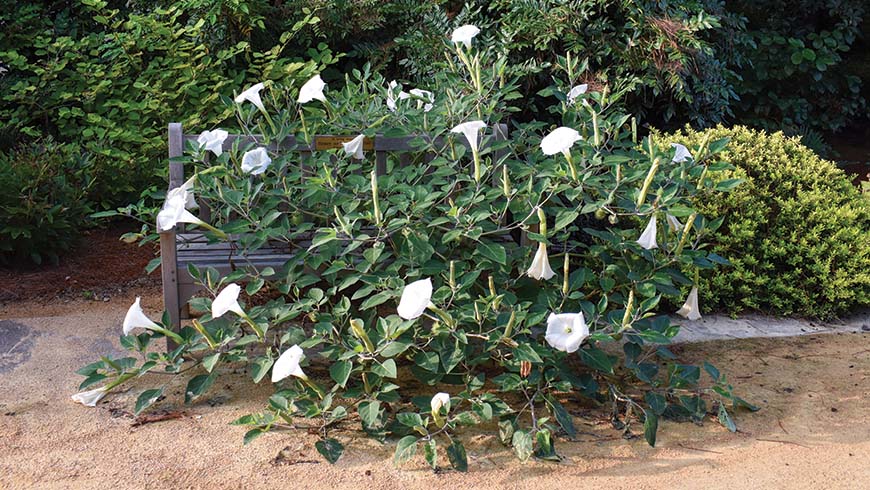
Mission Accomplished
By Arlene Calhoun, Assistant Director
The new year started with a clear vision for the Arboretum staff, volunteers, and members all working toward the most successful year on record. Without question, 2020 is one for the record books, but not exactly the way everyone envisioned.
The gates closed to the public on, March 16, and the staff quickly realized that the Arboretum would not be serving the community in the same ways it had for over 40 years. Seven months into the pandemic and counting, the gates are still closed as everyone followed university guidance to reduce the density of the campus population and keep safe all those who must return to campus.
Take a minute and imagine over 7,000 taxa alone on 10.5 acres. Missing are the 300 volunteers who groom and care for them as they grow. Missing are the thousands of visitors whose footsteps unknowingly help manage any unwelcomed growth along the garden paths and keep the wildlife from lingering a bit too long. Think—JCRA gone wild.
Okay, fun to think about, but somewhat exaggerated, since a construction crew was on-site installing a new drive around the Great Lawn, and the horticulture staff and summer interns slowly returned and dealt with the most pressing needs. Nevertheless, everyone agrees, things are not what they once were. Taking each day with ever-changing challenges and uncertainty, the Arboretum staff is more determined than ever to find ways to fulfill its mission and commitment to you. Your commitment and enthusiasm are what pushes the Arboretum staff to overcome barriers out of their control.
Nearly 300 people joined the first Zoom talk, Midweek with Mark, on April 1 (no fooling). That's over 30% more attendees than can fit in the York Auditorium. (I'd venture to say, most of us would have said, "Zoom what?!," on March 15.) Midweek with Mark proves to be as beneficial for you as the Arboretum staff. This weekly conversation and access to its director and staff is open to anyone who has time to join. It is a valuable way to talk about the current garden status along with a topic chosen by the director. Everyone is excited about this program's virtual reach and all the plant enthusiasts it attracts. One week, the audience spanned seven time zones, with people joining from Colorado to Belgium.
This virtual format will never replace the traditional face-to-face, hands-on programming everyone has grown to love, but it shows the potential of sharing the JC Raulston Arboretum's mission beyond its physical boundaries. As virtual programming has expanded, so too has the out-of-state participation and memberships. Out-of-state memberships have increased 28% over the same period last year: a reach the Arboretum hopes lasts long after this pandemic.
The JC Raulston Arboretum is an admission-free university trial garden, open to all who want to visit. The operating budget is not reliant on daily ticket sales, but rather the solid footings provided by those who believe in public horticulture, and what public gardens offer, even during a global pandemic.
As everyone battles "COVID fatigue," the Arboretum remains dedicated to connecting people and plants, being accessible and resilient, providing a clear way forward, and keeping its community strong and engaged.
With a passion for plants and a strong mission to educate, the Arboretum strives to be a leader. Pivoting when needed, maximizing reach, and prioritizing the importance of plants and horticulture, the Arboretum staff shares what they are continually learning with plant enthusiasts, garden lovers, and other institutions.
The latest technology allows the Arboretum to move forward, barely skipping a beat since the gates closed in March. The Arboretum staff is forever grateful to those of you who in recent years contributed to requests to fund laptop replacements for outdated desktops. These additions allowed most of the JCRA staff a seamless transition to a remote working environment where in just a matter of weeks they got online plant sales, educational programming, weekly talks, and updated online content in place—each giving success to the next, each providing confidence to keep moving forward.

You love plants, and so does everyone at the Arboretum. In case you have missed the news, the Plant Sale Buggy full of the latest offerings is pushed out the front gate each Tuesday and Thursday mornings. At the time of this writing, the Arboretum's Members-only Preorder Plant Sale is off to a great start. Combined with the successful modified plant giveaway on the first Saturday in October, your fall 2020 requirement for great plants is covered.
Fall is predicted to be a steep hill to climb without Moonlight in the Garden, but everything is being done to minimize expenses and focus on exciting programming that will appeal to plant enthusiasts everywhere. As with Moonlight in the Garden, new audiences are a primary objective, given the virtual reach of online programming.
Despite our current virtual focus, the Arboretum has not lost sight of the importance of physically visiting a public garden and connecting with nature. Our preference is to have the gates wide open and the gardens full of plant lovers.
However, in the current climate, Arboretum resources are better serving the community and fulfilling its mission by providing worthwhile virtual programming and controlled access to awesome plants, all the while keeping the garden safe and accessible to the various groups using it for higher learning and research. The Arboretum thanks you for your continued understanding and support as it finds alternate ways to share the passion for plants and love of horticulture.


